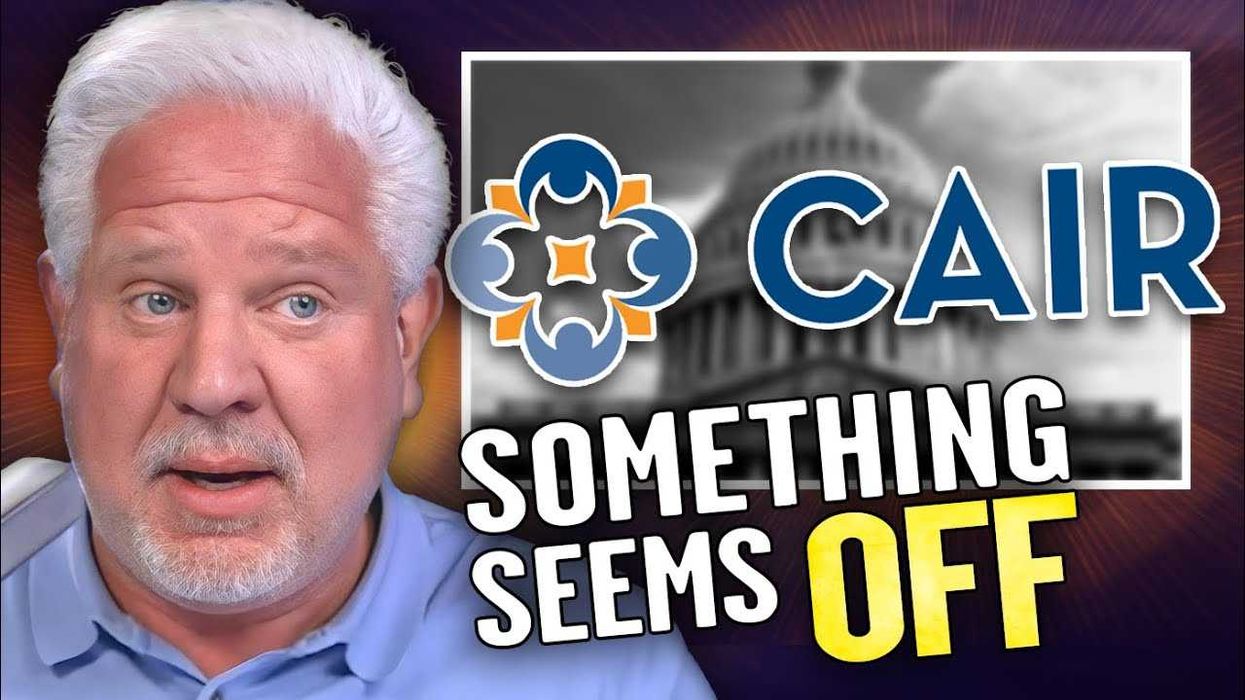A new report accuses CAIR Action, the political arm of the Council on American-Islamic Relations, of breaking state laws with its political activism. Glenn Beck reviews this story...
Transcript
Below is a rush transcript that may contain errors
GLENN: So let me go over what is -- what's happening with -- with CAIR.
You know, the Founding Fathers were obsessed over accountability.
Because they knew one thing. You know, they did. They must get suggestions from people on, you know, through tweets. They studied every single system of government.
Every single republic that survived. That didn't survive.
Why didn't it survive?
They studied all forms of government. They were trying to come up with something that could -- could set people free.
And they -- they worked really hard on putting our checks and balances in place, because they knew, once power slips into the shadows. They knew, once power slips into the shadows, once influence becomes unmoored from law, what rises is not a republic.
It's a machine. And that's what you're seeing right now. We're not living in a republic. We're living in a machine.
We -- I think we're staring at one of the largest unregulated political machines operating in the United States ever! Okay.
There have been a couple of groups that are doing sweeping investigations, two watchdog groups. One of them is NCRI and the Intelligent Advocacy Network.
And they have concluded now that the political arm of CAIR, he known as CAIR action, has been operating nationwide with no legal authority, to do the things it has been doing for years now.
They're not allowed to raise money. They've been raising money. Coordinating political campaigns.
Not allowed to do it. Endorsing candidates. Not allowed to do it, they're doing it. Mobilizing voters, shaping policy, functioning as a national advocacy network.
They don't have the legal authority to do any of it. And no one has said anything.
Now, according to the report, CAIR action doesn't just have a paperwork problem.
Investigators found, state by state, that it lacks the license, the registrations. The charitable authorizations, required to legally solicit money.
Excuse me. Or conduct political activity, in any of the 22 states in which it operates. Think of that!
I know how serious this is, because I remember what it took to get the license in each and every state, for Mercury One.
So we could operate. We could raise money. We could do things in those states. It's a lot of work. And if you don't do it, you go to jail. And they find out pretty quickly.
Okay?
22 states, they operate not one, zero legal authorization.
In Washington, DC, the city where CAIR action is incorporated, the department of licensing and consumer protection told investigators, they have no record of CAIR action ever obtaining the basic business license required to solicit funds or to operate.
Imagine how long would you last in business, especially if you were controversial.
How long would you remain in business, if you never had a business license?
You think somebody would figure that out?
In a sooner time than I don't know. A couple of decades!
This report means, that the organization if true, is engaging in unlicensed inner state solicitation.
It has exposed itself to allegations as serious as deceptive solicitation. Wire fraud and false statements to the IRS. These are big things.
And this is not political rhetoric.
Are these phrases written in black and white. In the law.
And by investigators. In California, one of CAIR's most active hubs. The state attorney general has said, the state attorney general of California has said, same pattern here!
The state of California, to say, yep. That's what's happening here.
CAIR action has never registered with California's charitable registry.
Never filed the required CT1 form. And has no authorization whatsoever to request donations. But they've been doing it in California anyway.
Fundraising, selling memberships. Issuing endorsements. Mobilizing voters. All of that has been done by CAIR action. There's no record of any license. Any permission, ever. Going to CAIR. From California. That's according to their attorney general.
Wow!
That's pretty remarkable, huh? How does that happen?
It's not just the coast. It is also happening to the Midwest, the South, the Mountain West. Every state hosting its own CAIR action fundraising page, complete with the donate now and become a member portal, despite no trace of the legal filings required to operate. That's bad!
Now, here's where the stakes rise.
Because CAIR action presents itself openly, as the political arm of CAIR National.
Investigators are now warning that any unauthorized fundraising or political activity.
Could become CAIR's national responsibility as well.
So, in other words, the parent, CAIR itself, might be held responsible.
Meaning, this is want just a rogue subdivision.
This could implicate the entire National Organization of CAIR.
Now, this is happening at the same time it's coming under national scrutiny. It's also Texas.
And I think Florida have designated the group a foreign terrorist organization. Members of Congress are now asking the IRS, the Treasury, the Department of Education to investigate all of its partnerships, all of its financing, all of its influence operations. I mean, I think they're going to be in trouble.
How long have we been saying this?
But every time, I have pointed out anything about CAIR, I have been called an Islamophobe, which shuts everything down. That is a word, developed by people like CAIR, to shut people down, so you'll never look into them.
So what happens next?
First of all, the reports have to hold up.
Regulators now have an obligation. Not a choice. An obligation to act!
State attorneys general in these 22 states, they might pursue fines, injunctions, criminal referrals.
All of them need to take action!
The IRS, needs to take action. Investigate tax exempt fraud. Treasury Department may review foreign influence or money flow violations.
Anything coming from overseas.
Oh, I can't imagine it. They're so buttoned up, right now.
DC regulators may determine whether CAIR actions entire fundraising operation has been unlawful from the beginning.
But here's the deeper question. And it's not bureaucratic. This one is constitutional.
Can the United States tolerate an influence machine, that operates outside of the legal framework, designed to prevent corruption, foreign leverage, and untraceable money?
If I hear one more time, talking about how AIPAC has just got to be investigated. Fine. Investigate.
I'm not against it.
Investigate.
Why aren't you saying anything about CAIR?
It feels like it might be a tool in the hands of a foreign operation.
Why aren't you saying anything about this?
Because here it is! It's not like, hey. I wonder why.
This is it! This is it! This isn't about silencing CAIR. Muslim Americans are -- that are full citizens, they have every right to speak. Every right to vote. Every right to organize. Participate in public life. No question! They can disagree with me, all they want.
But no organization. None! Not mine. Not yours. Not theirs. None. Should operate a nationwide political network, in the shadows and be immune from all of the guardrails that every other group must follow!
That's called a fourth branch of government!
That's how a fourth branch goes.
By the way, CAIR has placed all kinds of people in our Department of Homeland Security. Et cetera, et cetera. This organization has done it!
This is -- you cannot have a fourth branch of government.
They must abide by the laws.
No -- you can't have a branch that nobody elected. Nobody oversees.
Nobody holds accountable.
We talked about this yesterday, on yesterday's podcast. So what needs to happen is total transparency. CAIR action has to release its filings. Its donor structure. Its compliance records, if they exist. Equal enforcement under the law. I don't want them prosecuted in special ways.
Look, if AIPAC is doing the same thing. AIPAC should be prosecuted exactly the same way.
I want it equal. I want constitutional rule.
If conservatives, if Catholics, pro-Israel, environmental, Second Amendment groups, if they have to comply by the state law, so does CAIR action.
And if CAIR action has to do it, so do the Second Amendment groups and environmentalists, and pro-Israel and conservative groups. The law cannot be selective. It can't be!
I don't know how that's controversial in today's world. But somehow or another, they will find a way.
The Feds have to review all of this. If the report is accurate, the IRS and the Treasury have to determine whether false statements or unlicensed interstate solicitations have occurred.
Americans deserve to know what exactly, who is influencing our elections. Who is shaping our policy? Who is raising money in their state?
Especially physical the organization claims political authority, that it doesn't legally possess.
Because history will teach us one unchanging lesson. When a republic stops enforcing its own laws, someone else will always step in to fill that vacuum because power abhors a vacuum!
Unregulated, political power abhors a free people. So while it's about CAIR, it's not about Muslim Americans. It's not about religion.
As always, at least on this program, we try to make it about the rule of law.
One standard for everyone or no standard at all!
And that more than anything, will determine whether or not our institutions remain worthy of the freedom and responsibility that we have entrusted to them.





